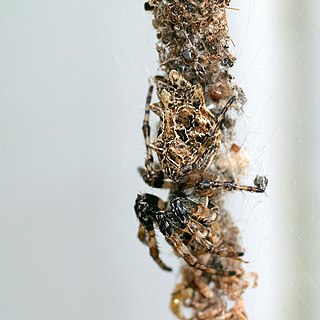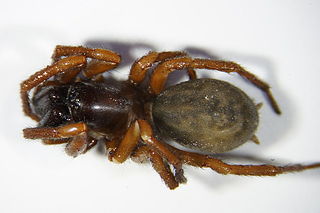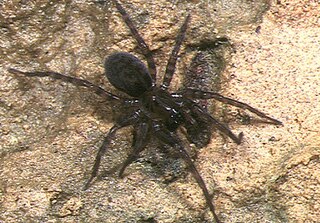
The Agelenidae are a large family of spiders in the suborder Araneomorphae. Well-known examples include the common "grass spiders" of the genus Agelenopsis. Nearly all Agelenidae are harmless to humans, but the bite of the hobo spider may be medically significant, and some evidence suggests it might cause necrotic lesions, but the matter remains subject to debate. The most widely accepted common name for members of the family is funnel weaver.

Xysticus is a genus of ground crab spiders described by C. L. Koch in 1835, belonging to the order Araneae, family Thomisidae. The genus name is derived from the Ancient Greek root xyst, meaning "scraped, scraper".

Cyclosa, also called trashline orbweavers, is a genus of orb-weaver spiders first described by Anton Menge in 1866. Widely distributed worldwide, spiders of the genus Cyclosa build relatively small orb webs with a web decoration. The web decoration in Cyclosa spiders is often linear and includes prey remains and other debris, which probably serve to camouflage the spider. The name "Cyclosa" comes from Greek 'to move in a circle', referring to how it spins its web.

Pholcus is a genus of spiders of long-bodied cellar spider and allies in the family Pholcidae, with 375 described species as of January 2023.

Clubiona is a genus of sac spiders that was first described by Pierre André Latreille in 1804.

Pachygnatha is a genus of long-jawed orb-weavers that was first described by Carl Jakob Sundevall in 1823.

Parasteatoda is a genus of comb-footed spiders that was first described by Allan Frost Archer in 1946. The name is a combination of the Ancient Greek "para-" (παρά), meaning "near" or "next to", and the theridiid genus Steatoda. The Japanese name for this genus is O-himegumo zoku.

Coelotes is a genus of funnel weavers first described by John Blackwall in 1841. A large number of species are found throughout Europe and Asia.

Platnickina is a genus of comb-footed spiders that was first described by A. Ö. Koçak & M. Kemal in 2008.

Iwogumoa is a genus of Asian funnel weavers first described by Kyukichi Kishida in 1955.

Cladothela is a genus of Asian ground spiders that was first described by Kyukichi Kishida in 1928.
Hitobia is a genus of Asian ground spiders that was first described by T. Kamura in 1992.

Paidiscura is a genus of comb-footed spiders that was first described by Allan Frost Archer in 1950.
Takayus is a genus of Asian comb-footed spiders that was first described by H. Yoshida in 2001.

Yunohamella is a genus of comb-footed spiders that was first described by H. Yoshida in 2007.
Draconarius is a genus of Asian funnel weavers first described by S. V. Ovtchinnikov in 1999.












